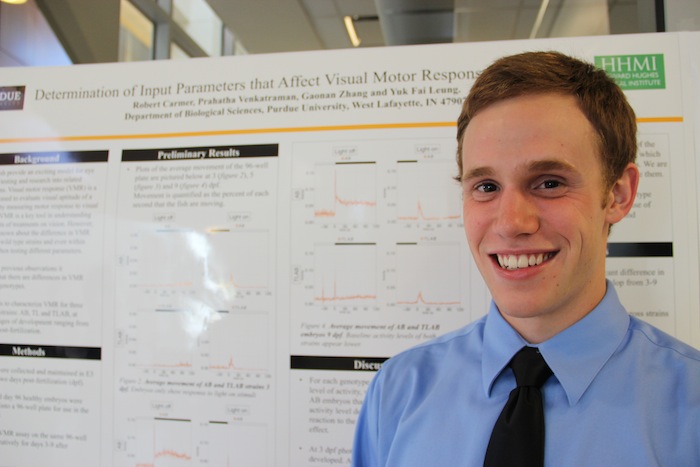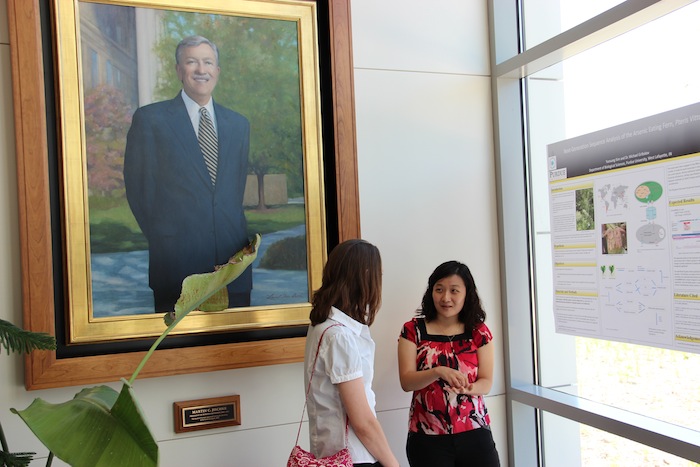Summer research project promotes collaboration between Statistics and Biological Sciences
06-17-2013

How does one make advances to an educational program that is larger than the sum of its individual parts? Through cooperation and communication between components, the life sciences programs at Purdue University have put forward a collective vision to promote teaching biology from a more quantitative perspective, funded by the Howard Hughes Medical Institute. Three key traits identified in moving forward on this initiative are the strong collaboration between departments, real-time adaptation of the program components to their constituents' needs and interests, and integration across the multiple efforts to leverage and learn from successes.
Biological Sciences and Statistics students were a part of the HHMI Mid-Summer Poster Session held June 14 at the Jischke Hall of Biomedical Engineering. Nine out of the 19 undergraduates that revealed their research, fielded questions and took in feedback at the event are from the College of Science. The others originate from Biochemistry in Agriculture and Biomedical Engineering. Still others came from other universities.
The undergraduate was teamed up with graduate students and/or faculty outside of the their major. For instance, if the Bio student wanted in on this round of summer research, they would be teamed up with Statistics faculty. A Stats student would be paired up with Bio faculty.
"The point of this is to hopefully give students a unique research research experience," said Lauren Turruso, research administrative assistant for Purdue's HHMI Science Education Program. "We are trying to stop this whole idea of there being a disconnect between life sciences and statistics."
Turroso said the summer research is designed for the students to improve themselves. While small, the HHMI project gets almost 300 applications for its 18 or 19 annual slots, she added.
The students' final research will be presented July 12 at the Discovery Learning Resource Center.
http://www.youtube.com/watch?v=1Ceqxwi6DMU
Four primary thrusts advance quantitative skills within the greater life sciences community: create Faculty Learning Communities; generate and disseminate teaching modules for curriculum development; support undergraduate research; and advance K-12 life science teacher preparation.
Engaged and well-trained Purdue instructors are critical for the continued progress of this program. Faculty Learning Communities (FLCs) were initiated with the goals to encourage the incorporation of statistics and experimental design into the life sciences curriculum and assess the impact of FLC participation on faculty attitudes and behavior. Starting as an institution with no history of FLCs, we now have a total of 28 individuals who have participated in the first three FLCs including faculty (life sciences and statistics), instructors, postdoctoral scientists, and graduate students. Teaching modules were developed with the combined participation of all FLC members. Since the establishment of our FLCs, the university has initiated a campus-wide program providing resources for faculty to redesign courses. Our FLCs are acting synergistically with this program, with faculty crossover between these efforts.
Incorporation of quantitative and data analysis skills throughout the undergraduate life sciences curricula will be enhanced not only by FLC trained instructors, but also by non-FLC instructors who adopt these skills into their course materials. To facilitate this and to lower the barriers to adoption, the main goal of the curriculum development portion is to generate and assess "plug and play" modules on topics in data analysis and experimental design using real or student-generated biological data. Instructors have developed modules largely in cooperation with the FLC. Given the diverse set of FLC members, the modules were developed for a variety of majors, levels of courses, and topics. This approach has the advantage of introducing a wide range of biological and statistical topics. To date, over 10 modules have been developed and used in classes and are available on Purdue's STEMEdHUB.
Classroom training in quantitative skills should better prepare students for open-ended, "real-world" scientific problems that they will experience as STEM researchers. The undergraduate summer research component provides that experience, bringing together faculty and undergraduate students from an array of academic institutions and disciplines to provide a facilitated "hands-on" research experience. This research experience was supported by weekly quantitative training sessions that were initially more of a short course but evolved to become active-learning problem based sessions. Each week, student teams addressed a problem by designing an experiment, collecting data, analyzing the data, and reporting back their findings, so these sessions have also proven to be incubators for new module ideas. By providing experiences analyzing authentic life science data, the students were expected to transfer the knowledge from these sessions to their own summer research projects, which have resulted in at least two publications with student co-authors.
An additional means to improve students' quantitative skills is to enhance their pre-college preparation. This can be achieved by helping grade 7-12 teachers to adopt quantitative skills and experimental design into their middle school and high school life science classrooms. The initial vision embedded the teachers within a proscribed lab experience which we adapted to better suit their needs and other ongoing educational initiatives such as AP Biology. It was found that the quantitative training sessions developed for the undergraduate summer research were appropriate for the teachers as well. They provided examples of lessons and lesson templates that they could bring back to their classroom and immediately do (at varying levels of complexity).
All components of the HHMI program at Purdue have evolved since they were initially proposed. This was driven by feedback from the students, teachers, and faculty involved, as well as by the assessments performed. For example, pre- and post-surveys of FLC participants' attitudes showed increased confidence in incorporating quantitative skills using peer instruction strategies and in identifying learning outcomes. Additional assessments, some of which have also been used in the summer program, have been deployed to create a profile of students' abilities and to evaluate the progress of modules in improving student outcomes. Further improvement and success are expected as the main identified challenges are addressed. These include further dissemination of instructional modules beyond FLC instructors, which was addressed in a recent workshop on modules attended by over 15 non-FLC instructors. Continued use of modules by faculty and teachers will permit refinement and adaptation to a wide range of biological topics that use similar statistical or analytic techniques. Finally, better student outcomes and research outcomes will help students and faculty embrace quantitative analysis as an integral and integrated part of training in modern life sciences.

Article originally appeared on the Purdue College of Science website